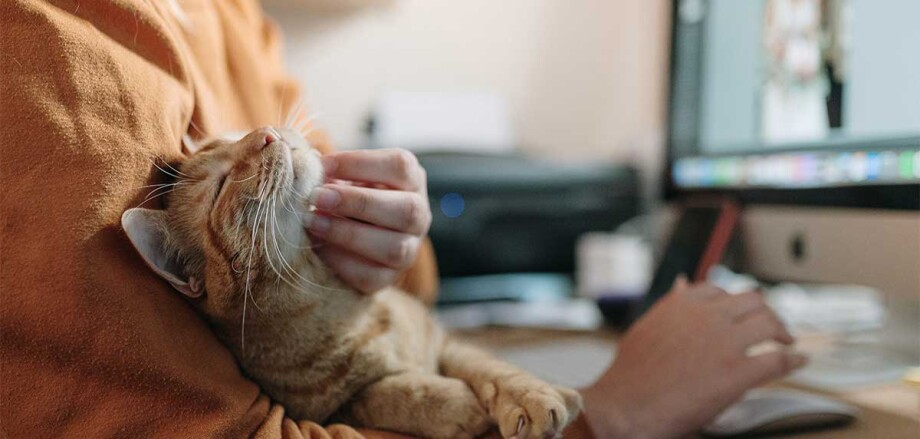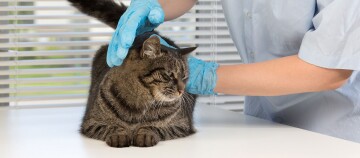The age of a cat in human years and its maximum age
03.01.2024 - Reading time: 6 minutes

Find out how old your cat is in human years
As the proud owner of a cat, you may be wondering how old your cat is in human years. Is it enough to multiply their age by a number? The answer is no because cats do not grow linearly. By taking this information into account, it is possible to calculate equivalences, bearing in mind that a cat’s maximum age varies depending on its breed and living conditions.
What age is my cat in human years?
Perhaps you have noticed small signs of ageing in your cat and would like to know their age in human years. This conversion gives many owners a better understanding of the needs of their little four-legged friends. Unfortunately, pets such as cats live much shorter lives than humans. Unlike human beings, a cat that is already quite old may still look young. In order to look after a cat properly throughout its life, it’s sometimes a good idea to consider how old it would be if it were a human being. Of course, this information is for guidance only and may vary from one cat to another. Find out how to recognise when your cat becomes an adolescent, then an adult and finally a senior or perhaps even a super-senior.
How do you calculate the age of your cat?
Have you heard that you need to multiply the age of a cat by seven to find out its age in human years? This is wrong. The number seven is only relevant to cats when it comes to their famous seven lives. But how do you find out the age of a cat in human years? First of all, cats grow very quickly during their first two years. This does not make it easy to calculate a cat’s age in human terms. A-one-year old cat would therefore be around 15 and a two-year-old cat would be 24 in human years. After that, it ages much more slowly and in a fairly linear manner. As with other pets, factors such as poor diet, stress and lack of exercise can lead to ageing faster. In this case, prevention is better than cure by providing your cat with the best possible environment for a long and healthy life.
Use the table below to find out what a cat’s age corresponds to in human terms:
Age of cat | Age in human years |
|---|---|
1 month | 6 months |
between 2 and 3 months | between 2 and 5 years |
4 months | between 6 and 8 years |
6 months | 10 years |
7 months | 12 years |
12 months | between 15 and 16 years |
18 months | between 20 and 21 years |
2 years | 24 years |
3 years | 28 years |
4 years | 32 years |
5 years | 36 years |
6 years | 40 years |
7 years | 44 years |
8 years | 48 years |
9 years | 52 years |
10 years | 56 years |
11 years | 61 years |
12 years | 64 years |
13 years | 68 years |
14 years | 72 years |
15 years | 76 years |
16 years | 80 years |
17 years | 84 years |
18 years | 88 years |
19 years | 92 years |
20 years | 96 years |
At what age does a cat become an adult?
It’s hard not to fall in love with those adorable little balls of fur that are kittens. We’d like them to stay that way for a long time; playful, intrepid, sometimes clumsy and often cuddly too. But by the age of six months, the young cat already looks more like an adult cat than a kitten. Does that mean that your little companion is already an adult? Not yet. They can be considered a teenager. Be careful, however, if you have several cats, including males and females, as they are already capable of reproducing at this age. Your vet will be able to advise you and tell you when to have your cat neutered. Depending on its breed, your cat will reach full adulthood between 12 and 24 months. Adapt your cat’s diet according to its age by giving them adult cat food, lower in fat and protein than kitten food. An adult cat moves less than a kitten and therefore needs less calories. This is especially true if your cat does not go out and is neutered.
What is the life expectancy of a cat?
By welcoming a cat into your home, you are making a commitment for many years to come. A cat with a good genetic predisposition and living in an optimal environment can live for 20 years or more. The average life expectancy of cats is between 10 and 16 years depending on the breed. Here is the life expectancy of different breeds of cat:
- Siamese cat: between 15 and 21 years
- Persian cat: between 10 and 17 years
- Maine Coon cat: between 10 and 15 years
- Burmese cat: between 14 and 17 years
- British Shorthair cat: between 15 and 20 years
The cats often referred to as alley cats have the greatest chance of living a long life. Provided, of course, that they have good living conditions including a healthy diet and a secure living space. It goes without saying that the life expectancy of cats living outdoors is generally lower. This is due to dangers such as the risk of being run over by a vehicle or being injured by another animal.
What is the maximum age of a cat?
Cats live several years longer than dogs. It’s not unusual for a cat to reach 20. Some cats have even lived for more than three decades. That was the case for Creme Puff, a cat that was born in Texas in 1967 and died in 2005. Her age was equivalent to 168 in human years! This earned her a place in the Guinness Book of Records. Her owner Jake Perry had already had a cat with an exceptional lifespan: Granpa, who died in 1998 at 34 years old. It would appear that the unconventional diet of these two cats contributed to their advanced age. In an interview published in Cats & Kittens in 1999, Mr Perry recounts how he used to spoil his cats with bacon, eggs and cooked vegetables such as broccoli. The oldest living cat is currently Flossie, born in 1995 in the United Kingdom.
What can you do to increase the life expectancy of a cat?
When you buy a cat, you become responsible for its health and well-being. Don’t forget that even if your cat is in good shape, they still become a senior citizen from the age of 10. You may notice this because they start to sleep more and don’t want to play as much. Continue to give them a high-quality diet suitable for their needs. Food for older cats is easier to chew and contains what your cat needs to stay healthy. Make sure your faithful companion doesn’t put on weight with age. A health check at your vets once a year allows early detection of potential diseases. By taking good care of your cat, you will increase their chances of becoming a super-senior.


